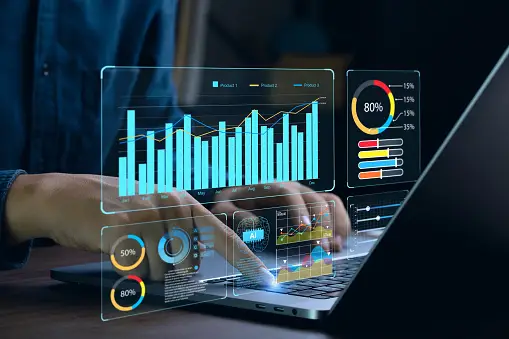
Data and analytics are essential components of informed decision-making in various fields, including business, healthcare, finance, and more. Here’s an overview of data and analytics:
Data:
– Refers to the collection of raw, unprocessed facts and figures
– Can be structured (e.g., databases) or unstructured (e.g., text, images)
– Examples: sales figures, customer demographics, website traffic
Analytics:
– Involves examining data to draw conclusions and identify patterns
– Uses various techniques, such as statistical modeling, data mining, and machine learning
– Aims to turn data into actionable insights and knowledge
Types of Analytics:
1. Descriptive Analytics: Analyzes historical data to understand what happened.
2. Diagnostic Analytics: Examines data to identify why something happened.
3. Predictive Analytics: Uses statistical models and machine learning to forecast what may happen.
4. Prescriptive Analytics: Provides recommendations on what actions to take.
Tools and Techniques:
1. Visualization: Uses charts, graphs, and other visualizations to communicate insights.
2. Machine Learning: Employs algorithms to identify patterns and make predictions.
3. Statistical Analysis: Applies statistical methods to understand data.
4. Data Mining: Extracts valuable insights from large datasets.
Applications:
1. Business: Optimizes operations, marketing, and finance.
2. Healthcare: Improves patient outcomes, resource allocation, and research.
3. Finance: Enhances investment decisions, risk management, and fraud detection.
4. Sports: Analyzes player performance, team strategy, and fan engagement.
Benefits:
1. Informed Decision-Making: Data-driven insights lead to better choices.
2. Improved Efficiency: Analytics optimizes processes and resource allocation.
3. Competitive Advantage: Organizations leveraging analytics gain an edge.
4. Innovation: Analytics enables new products, services, and business models.
By harnessing the power of data and analytics, organizations can drive growth, innovation, and success.
Building a career in data analytics requires a combination of skills, experience, and continuous learning. Here’s a step-by-step guide to help you get started:
1. Develop a strong foundation in math and statistics:
– Linear algebra, calculus, probability, and statistics are essential.
2. Learn programming skills:
– Python, R, and SQL are popular languages in data analytics.
3. Get familiar with data visualization tools:
– Tableau, Power BI, and D3.js are industry-standard tools.
4. Understand machine learning and algorithms:
– Study supervised and unsupervised learning, regression, and clustering.
5. Work with databases and data management:
– Understand data modeling, data warehousing, and ETL processes.
6. Gain experience with data analysis and interpretation:
– Practice working with datasets, creating reports, and presenting insights.
7. Pursue certifications and training:
– Consider Certified Data Analyst (CDA) or Certified Analytics Professional (CAP) certifications.
8. Build a portfolio of projects:
– Showcase your skills by working on personal projects or contributing to open-source initiatives.
9. Network and join professional organizations:
– Attend conferences, and meetups, and join groups like the Data Science Council of America (DASCA).
10. Stay up-to-date with industry trends and tools:
– Follow industry leaders, blogs, and publications to stay informed.
11. Consider a graduate degree in data science or analytics:
– A master’s degree can help you advance your career and earn higher salaries.
12. Develop soft skills:
– Communication, collaboration, and problem-solving skills are essential for success.
Remember, building a career in data analytics takes time, dedication, and continuous learning. Focus on developing a strong foundation, staying up-to-date with industry trends, and showcasing your skills to potential employers.

